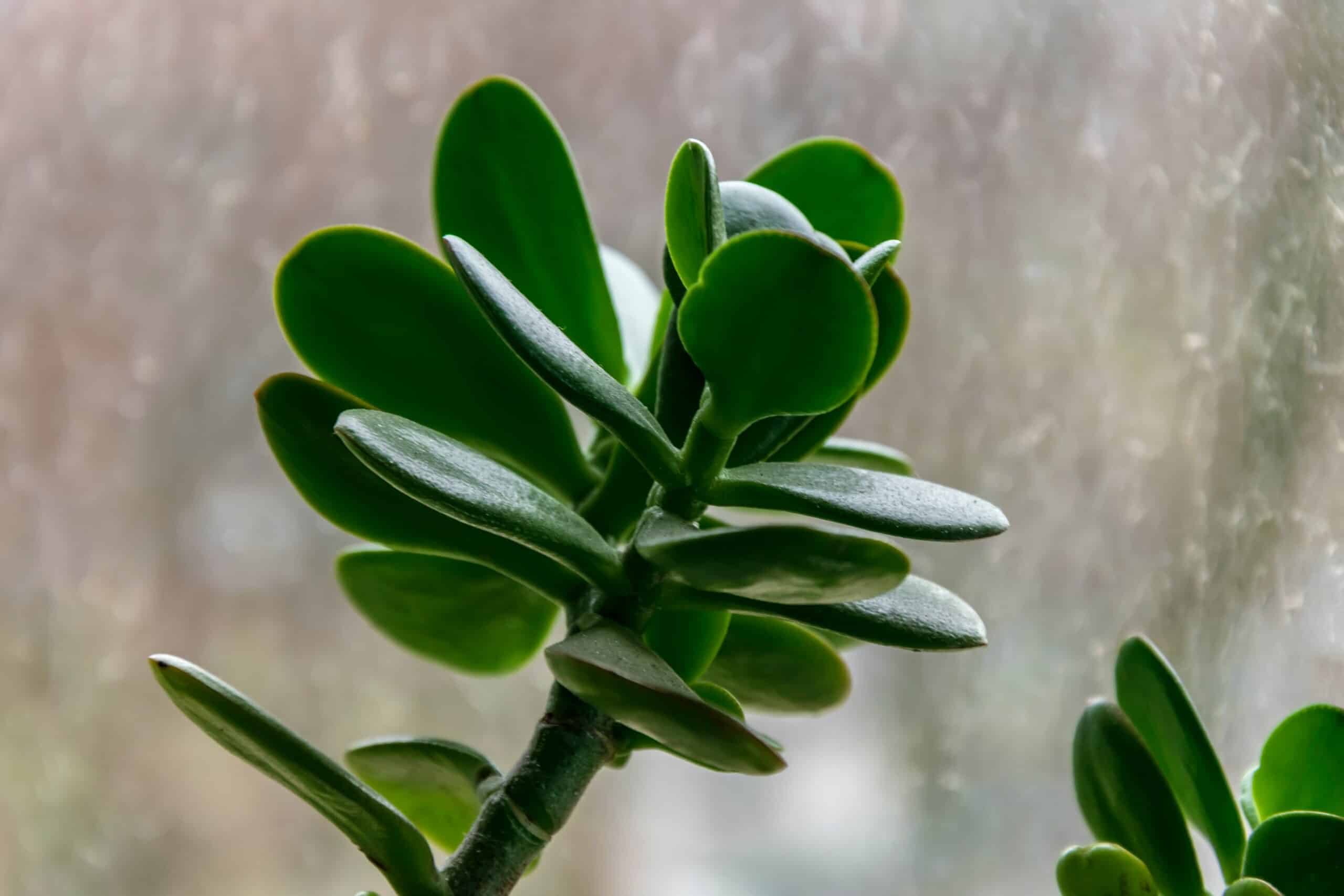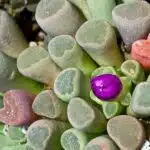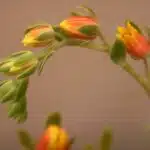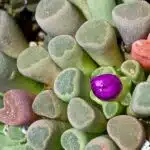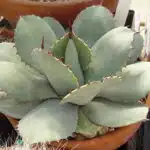Are you looking to add a unique and eye-catching addition to your garden or home? Crassula perforata, commonly known as string of buttons, could be just the plant for you! Despite its delicate appearance, this succulent is a hardy and easy-to-care-for species that will bring color and texture to any space.
Maybe you’re hesitant about adding a new plant to your collection due to the cost or time associated with care? Don’t worry—string of buttons requires minimal maintenance and can thrive for many years with the proper care. As an experienced botanist and gardener, I am here to guide you through the steps of growing and caring for this lovely succulent.
String of buttons features small, round leaves connected by thin stems that cascade down from its pot. Its evergreen foliage is covered in white dots that make it look like it’s dusted in snow. The plant also produces yellow star-shaped flowers during certain times of year. With its charming aesthetic and exceptional resilience, string of buttons makes a wonderful addition to any indoor or outdoor space!
What Is Crassula Perforata?
Crassula perforata, often referred to as the string of buttons, is like a cascade of green pearls cascading down from the heavens. Its delicate leaves and intricate structure make it an ideal addition to any garden. This succulent plant is incredibly easy to care for and requires very little maintenance.
Native to South Africa, Crassula perforata is a small evergreen perennial with pendant stems that hold clusters of tiny, round leaves. It can reach up to 18 inches in length and grows best in partial sun or shade. The beautiful foliage of this plant provides a wonderful contrast to other plants in your garden.
In order to get the most out of your Crassula perforata, you’ll need to provide it with proper planting requirements such as well-draining soil, plenty of sunlight, and regular watering. The key is learning how much water and light your plant needs so that it can thrive in its environment. With the right care and attention, you can be sure that your string of buttons will stay healthy and happy for years!
Planting Requirements
It’s ironic how such a seemingly delicate plant requires more than a simple, gentle touch to thrive. Crassula perforata, otherwise known as ‘String of Buttons’, is an intriguing succulent that can bring life and color to any home or garden. But what kind of planting requirements does it need?
As an evergreen succulent, it prefers full sun and light shade, but will tolerate partial shade. An ideal location should provide 6-8 hours of sunlight daily in the summer months and slightly less during the winter season. When planting outdoors, be sure to choose a spot with good air circulation and well-draining soil for optimal growth. You’ll also want to give your plant plenty of room to spread its roots – at least 8-12 inches apart from other plants.
When potting your String of Buttons indoors, use a container with good drainage holes and select a quality potting mix specifically designed for cacti and succulents. Make sure you don’t fill the container too deeply; this can cause root rot or even death if the soil remains too wet for too long. It’s best to water your Crassula perforata thoroughly, then allow the soil to dry out before watering again – this should keep your plant happy and healthy!
Providing ample sunlight and well-draining soil are essential components for successful cultivation of String of Buttons. With adequate care and attention, these fascinating little plants can make wonderful additions to any garden or home!
Soil Requirements
Growing Crassula perforata, best known as the string of buttons, requires a soil with specific qualities. This succulent is a tough but delicate plant that needs proper care to thrive. It’s like a tightrope walk between providing the right amount of moisture and allowing it to dry out completely. To maintain this balance, it’s essential to choose the right soil for your string of buttons plant.
Soil for crassula perforata should be well-draining yet retain some moisture without becoming soggy. A mixture of potting soil, compost or peat moss, and sand or perlite creates an ideal environment for the plant’s roots to grow strong and healthy. The soil should also be light and airy so that water can easily drain away from the roots while still retaining some moisture in the air pockets between particles. Adding organic matter like compost or humus helps create an environment with better drainage while still promoting aeration around the roots.
For best results, use a container with drainage holes and add extra gravel or stones at the bottom before filling it with soil mix. This will allow excess water to drain away quickly without saturating your plant’s roots, preventing root rot and other diseases caused by overwatering. With these tips in mind, your String of Buttons will be perfectly content in its new home! Now let’s move on to discussing necessary sunlight requirements for this fascinating succulent species.
Sunlight Requirements
Sunlight is the key to unlocking a flourishing String of Buttons. Like a sun-loving flower, this succulent requires plenty of sunlight to thrive and remain healthy. Think of it like sunshine is its water – without it, the plant will dry out and eventually fade away.
To get the most out of your String of Buttons, choose a spot that receives full sun for at least four hours each day. If you live in cooler climates or areas with longer winters, aim for six or more hours of direct sunlight per day. It’s always important to monitor how much light your plant is getting – too little can lead to stretching and etiolation, while too much can cause leaves to burn and dry out.
For best results, give your String of Buttons a south-facing window if possible for maximum exposure to the sun’s rays. If you don’t have access to a sunny window indoors, you could also place the pot outside in an area protected from strong winds and direct afternoon sun during hot summer months. Just be sure to bring it back inside before temperatures drop below freezing!
Temperature Requirements
It’s time to talk temperature – a vital factor in keeping your String of Buttons healthy and thriving. Juxtaposed against the sunlight requirements, this is an equally important step in ensuring your succulent continues to thrive. Let’s take a look at how the right temperature can help you grow the perfect String of Buttons!
As with other succulents, Crassula perforata prefers warm temperatures when growing. During winter, temperatures should stay above 15°C (59°F). In summer, they can endure slightly higher temperatures up to 28°C (83°F). So if you live in a warm climate, you’re in luck: with its preference for sunny spots and warm temperatures, Crassula perforata will do well outside year-round.
However, if you have cold winters or live in a cooler climate, it’s best to keep your plant indoors or bring it inside during colder months. This way you can protect it from any sudden temperature drops and ensure that it is getting all the warmth it needs without disrupting its growth cycle. Additionally, make sure to avoid placing near heaters or vents that could dry out the environment too quickly and affect your succulent’s health.
By taking the right temperature into consideration when caring for your String of Buttons, you’ll be able to ensure its continued success – so let’s move on to watering requirements next!
Watering Requirements
Watering requirements for a String of Buttons (Crassula perforata) can be easily managed with the right conditions and knowledge. It is estimated that around 60% of houseplant deaths are caused by incorrect watering, so it is important to understand how to water this particular succulent correctly. Here are 6 tips on how to properly water a String of Buttons:
- Water the succulent deeply only when the soil is dry, never more than once every 10-14 days in the summertime and less often in winter.
- Use lukewarm water or rainwater which has been allowed to come to room temperature naturally.
- Don’t allow standing water – allow excess to drain away fully before returning it to its pot.
- Mist the leaves occasionally with a spray bottle filled with lukewarm water if desired.
- Avoid overwatering as this will lead to root rot and fungal infections which can kill your succulent quickly – use good judgement when deciding when and how much to water your plant based on its environment and size of potting container used.
- If you’re unsure whether or not your Crassula perforata needs watering, check its soil with a finger – if it is completely dry up until your first knuckle then it’s time for a drink!
By following these simple guidelines, you will ensure that your String of Buttons enjoys healthy growth and blooming potential! Next we’ll discuss pruning and propagation techniques for this unique plant species, so stay tuned!
Pruning And Propagation
Growing and caring for crassula perforata is an incredibly rewarding experience! Focusing on pruning and propagation is the key to cultivating a lush and healthy plant. It’s quite remarkable, really; a few snips here and there can make all the difference in your journey to becoming a master gardener.
The most important thing to remember when pruning string of buttons is to never remove more than one-third of the foliage at any given time – this will ensure that you don’t shock the plant. For best results, use sharp scissors or a clean pair of garden shears in order to reduce damage to the stem. Strategic pruning of long stems can also help encourage bushier growth, as well as promoting more flowers during blooming season.
Propagation with string of buttons is relatively easy, and can be done at any time throughout the year. To begin, simply trim off stems that have several leaves attached and place them into water or damp soil; roots should form within a few weeks. Alternatively, you can take cuttings from mature plants – just be sure to wait until after blooming season has ended before doing so! With either method, you’ll soon have plenty of new additions to add to your collection.
Whatever approach you take towards pruning and propagation, rest assured that you’re helping ensure the healthiest possible environment for your crassula perforata! Once successful rooting has occurred, you’ll be ready to move onto fertilizing requirements in order to keep your plant thriving in its new home.
Fertilizing Requirements
Fertilizing requirements are the secret to cultivating a healthy and robust String of Buttons (Crassula perforata) plant. To ensure that your succulent blooms with lush foliage, it’s important to understand when, why and how to fertilize. As a specialist in botany and gardening, here are my guidelines on this critical matter:
- Fertilize only once or twice during the spring and summer months.
- Use a balanced fertilizer with an NPK value of 10-10-10 at half strength for optimal results.
- Water well after fertilizing to help the nutrients sink in to the soil.
- Avoid fertilizing in fall and winter as they’re rest periods for the plant and you don’t want to shock it with too many nutrients.
Aside from these points, it’s also essential to remember that over-fertilizing can cause damage or death to your succulent – so make sure you follow these instructions carefully! The best way to prevent accidental over-fertilization is by using a slow-release fertilizer method – this will provide a steady dose of nourishment without any fear of excess. With the right fertilizer regime in place, you will be rewarded with an abundant growth of String of Buttons blooms adorning your garden space!
Now that we’ve discussed fertilization, let’s move on and discuss pest and disease management – another key factor in keeping your String of Buttons vibrant and healthy!
Pest And Disease Management
When it comes to keeping your String of Buttons in peak condition, pest and disease management is key. As a gardener, I’ve had my fair share of battles with pests and diseases over the years, and it’s never a pleasant experience. However, with proper preventative measures and early detection of problems, you can save yourself a lot of time and hassle.
The first step in managing pests and diseases is prevention. Make sure to use insecticidal soaps or oils on your plants to provide them with an extra layer of protection against aphids and other common garden pests. Additionally, keep an eye out for any signs of fungal diseases like powdery mildew or leaf spot. If you notice any discoloration or unusual spots on the leaves of your String of Buttons, remove the affected parts immediately to help stop the spread.
Finally, you should also make sure that your plant isn’t being stressed by too little or too much water or light. Overwatering can lead to root rot while overwintering can cause yellowed leaves or stunted growth. If you maintain proper soil moisture levels and provide enough sunlight for your String of Buttons, then you’ll have taken one more step towards preventing pests and diseases from taking hold in your garden.
By following these guidelines, you’ll be able to keep your String of Buttons healthy and happy for many years to come – without having to worry about any unwelcome visitors!
Signs Of Stress And Overwatering
Though it may seem difficult to determine when a crassula perforata needs care, there are some key signs that can be easily spotted. A string of buttons is a beautiful, low-maintenance succulent, but it still needs attention from time to time. Let’s delve into the signs of stress and overwatering in this delicate plant.
Stress in a crassula perforata can often manifest itself through wilting leaves or stems. Wilting is an indication that the plant is either too dry or too wet, so you must examine your watering habits and adjust accordingly. Additionally, leaves that turn yellow and become soft are also indicators of overwatering; if you notice these signs, reduce your watering frequency right away!
Lastly – and perhaps most tellingly – soggy soil at the bottom of the pot is indicative of overwatering. If this is the case with your crassula perforata, empty out any excess water and allow the soil to dry before watering again. This will help ensure that your string of buttons remains healthy for many years to come.
By understanding these warning signs, you can better provide proper care for your crassula perforata without overdoing it. With a few simple adjustments in its environment, this gorgeous little succulent will thrive!
Tips For Healthy Growth
Now that you know the signs of stress and overwatering, it’s time to focus on tips for healthy growth. Growing string of buttons (Crassula perforata) isn’t difficult, but there are a few things you should keep in mind to give your plant the best chance at success. First and foremost: light and water.
String of buttons needs lots of bright indirect sunlight to thrive, so place it in an area with lots of exposure during the day. To determine how much water your plant needs, stick your finger into the soil up to the first knuckle; if it feels dry, water deeply until moisture begins to seep out from the bottom drainage holes. Letting the soil dry between watering sessions helps prevent root rot and other diseases caused by excess moisture.
Fertilizer is also important for healthy growth; use a slow-release fertilizer or liquid fertilizer every two weeks during its growing season (spring and summer). This will help replenish essential nutrients that may have been depleted over time and provide additional nourishment for strong, vibrant foliage. Caring for Crassula perforata doesn’t have to be complicated – just follow these simple steps for beautiful, lush plants all year round!
Lastly, repotting requirements vary depending on the size of your plant; small plants may only need repotting once every one or two years while larger specimens may need repotting annually. When selecting a new pot for repotting your string of buttons, make sure it has adequate drainage holes so excess water can escape easily. Additionally, use a well-draining potting mix specifically designed for succulents to ensure proper aeration around roots which is essential for healthy growth.
Repotting Requirements
What an irony! We think that repotting is a requirement only for plants that are growing too big, but the exact opposite is true for Crassula perforata. This string-of-buttons plant needs periodic repotting to keep it healthy and happy.
You see, this succulent thrives in shallow containers, which helps promote air circulation and faster drying of the soil. It’s important to repot at least once every two years so that the soil remains nutrient-rich and well-aerated. The best time of year to repot your string-of-buttons is during spring when its growth is most active.
When you’re ready to start repotting, make sure you use a pot with drainage holes in the bottom to allow excess water to escape. Use a light, well-draining mix such as cactus potting soil or equal parts of sand and peat moss. When you’re done, give your new plant a good watering and allow it to dry out before giving it another drink.
With these tips in mind, you’ll have a healthy string-of-buttons in no time! The next step is learning how this unique succulent can be used in landscaping projects around your home.
Uses In Landscaping
String of Buttons (Crassula perforata) is an extraordinary plant with a unique appearance that can adds beauty and texture to any outdoor landscaping. Its cascading stems, adorned with tiny round leaves, have a whimsical charm that brings life to even the dullest garden. Beyond its beauty, this succulent is also highly versatile in terms of landscaping uses.
In addition to being grown in containers and hanging baskets, Crassula perforata can be used as ground cover, edging plants for pathways or planted along walls or fences. It’s ideal for rock gardens as it thrives in well-drained soil and can handle full sun and drought conditions. When planting outdoors, make sure you space the specimens at least 20 cm apart and select an area with good drainage to prevent root rot.
For those wanting to use String of Buttons as an indoor houseplant, it looks best when allowed to spill over the sides of the pot or basket. For best results, water sparingly but thoroughly so that all parts of the soil are evenly moistened – usually once every two weeks should suffice during summer months. In winter, reduce watering frequency slightly as the plant goes dormant during this period. With proper care and maintenance, Crassula perforata will thrive both indoors and out for many years!
Common Questions
When caring for a String of Buttons (Crassula perforata), many common questions can arise. For example, how often should you water the plant? What type of soil is best for it to thrive? To answer these and other questions, here is a brief overview of what you need to know.
Firstly, this succulent requires plenty of sunlight to encourage healthy growth. Place it in an area with bright indirect light or full sun for at least four hours each day. It’s also important to ensure that the soil drains well, as too much moisture can cause root rot. Choose a potting mix designed for succulents with good drainage properties and add some extra perlite or pumice if necessary.
When watering your String of Buttons, make sure not to overwater it. Allow the top few inches of soil to dry out completely before giving it a deep drink and wait until the soil has dried out again before repeating the process. During winter, reduce watering even further as the plant will go dormant during this period anyway.
TIP: Fertilizing your String of Buttons regularly over spring and summer can help maintain its health and vigor. Use a balanced liquid fertilizer at half strength every two weeks during its active growth phase from April to August for best results.
Troubleshooting Tips
When it comes to gardening, troubleshooting is an important part of the process. It’s a bit like having a detective on the case looking for clues and solving puzzles. As botanists and gardeners, we have to look at all the evidence and use our expertise to identify what might be happening with our plants. When it comes to caring for a crassula perforata (String of Buttons), here are some troubleshooting tips that can help you figure out what’s going wrong:
- Check your water levels – Crassulas need consistent moisture in order to thrive, so make sure you’re watering regularly and that your soil isn’t becoming too dry or too wet.
- Look for signs of disease – Inspect your plant carefully for any signs of wilting or discoloration that could point to fungal infection or other diseases.
- Examine light exposure – Too much sun can lead to scorched leaves, while too little can stunt growth and cause yellowing. Make sure your plant is getting enough indirect sunlight without getting burned by direct rays.
- Monitor temperature – Crassulas prefer temperatures between 65-75°F during the day and slightly cooler at night. Extreme temperatures can cause stress on the plant which may lead to problems.
- Check for pests – Aphids, mealybugs, scale insects, and spider mites can all infest String of Buttons plants if they’re not treated quickly enough. Keep an eye out for these pesky critters so you can act fast if needed!
Troubleshooting your crassula perforata requires patience and attention to detail — but with a bit of detective work, you should be able to find the source of any issues you’re experiencing with this unique succulent plant! By following these tips, you’ll be better equipped to give it the care it needs so that it will thrive in your garden for years to come!
Frequently Asked Questions
How Often Should I Water Crassula Perforata?
When it comes to proper watering for Crassula perforata, or string of buttons, it’s important to get the balance just right. Too much water can be detrimental, but an occasional deep soak can help keep the plant healthy. Here is how you can best care for this succulent and ensure its long-term health:
Firstly, water your string of buttons deeply and infrequently. This means that you should wait until the soil has dried out completely before giving your plant a thorough soaking. You can also check the moisture level in the soil by sticking your finger into it; if it feels dry an inch down, then it is time to water.
Next, make sure that you are using well-draining soil when potting your string of buttons. This succulent does not like soggy soil or root rot, so making sure there is good drainage will help keep it healthy. Additionally, provide plenty of bright light to ensure that your string of buttons grows properly and blooms as desired.
Finally, here are some helpful tips to remember when caring for Crassula perforata: • Water deeply and infrequently • Use well-draining soil • Provide plenty of bright light • Keep away from cold temperatures By following these guidelines and taking proper care of your plant, you can ensure the long-term health and growth of your Crassula perforata!
What Type Of Fertilizer Is Best For Crassula Perforata?
Taking care of a Crassula perforata is like taking care of a newborn baby. It needs the right balance of nutrients to thrive and reach its full potential. Fertilizing with the correct type and amount of fertilizer can be the difference between success and failure for this delicate succulent. As an experienced botanist, I’ll share my knowledge on selecting the ideal fertilizer for your String-of-Buttons plant.
When it comes to fertilizing Crassula perforata, there are several options available. A liquid or water-soluble fertilizer is best as it allows quick absorption by the plant’s roots and leaves. This type of fertilizer should be used every two weeks during the spring and summer months when growth is at its peak. If you choose a granular or slow-release fertilizer, then you should apply it once a month during these same months.
The type of fertilizer you use also matters when caring for your succulent. A balanced 10-10-10 formulation will provide all three essential macronutrients – nitrogen, phosphorus, and potassium – that are necessary for growth and flowering. A 20-20-20 blend will ensure even more robust growth but may increase leaching from the soil, so use this with caution if you’re growing in containers or indoors. Organic fertilizers such as manure tea or compost tea can also be used at half strength once a month to provide additional nutrients without causing excessive leaching.
No matter what type of fertilizer you choose, always read and follow the directions carefully to avoid overfertilizing, which can lead to yellowing leaves or stunted growth in your Crassula perforata plant!
Can I Grow Crassula Perforata Indoors?
The succulent Crassula perforata, commonly known as the String of Buttons, is a fast-growing, low-maintenance species that is perfect for both indoor and outdoor gardens. While this plant typically grows in full sun outdoors in warmer climates, it can also thrive indoors in containers or hanging baskets. So if you’re looking to add a unique touch to your home or garden, the String of Buttons could be the ideal choice!
As with most succulents, String of Buttons will do best in well-draining soil with plenty of organic material. A light liquid fertilizer can help keep them looking their best. Avoid over-fertilizing and only apply once every two weeks during the growing season. If your plant is receiving too much fertilizer, its leaves may become yellow and drop off.
Though this drought-tolerant species prefers bright light for optimal growth indoors, it will tolerate lower light levels as long as it doesn’t get too much direct sunlight. When grown indoors, make sure not to overwater; allow the soil to dry out completely between waterings. With proper care and attention, your String of Buttons should grow vigorously and produce beautiful clusters of tiny flowers year-round!
For those who want to add a delightful burst of color to their living space or garden without having to expend much effort, Crassula perforata is an excellent option. With its easy-care needs and vibrant blooms, this charming succulent can offer years of enjoyment!
What Are The Best Temperatures For Growing Crassula Perforata?
Crassula perforata, also known as String of Buttons, is a beautiful succulent that can be grown both indoors and outdoors. While it’s well suited for growing in warm climates, understanding the best temperatures for this plant is essential for successful cultivation. Here we’ll discuss what temperatures are ideal for healthy growth of your Crassula perforata.
First of all, Crassula perforata prefers daytime temperatures between 65°F and 75°F (18°C to 24°C). It should also receive some hours of direct sunlight each day; however, too much intense sunlight may burn the foliage. Here’s a quick summary of temperatures you should keep in mind:
- 65°F to 75°F (18°C to 24°C) during the day;
- 45°F to 55°F (7°C to 13°C) at night;
- 5 hours of direct sun each day;
- Avoid extreme heat or cold that could damage the plant.
When temperatures drop below freezing point at night, it’s best to move your String of Buttons indoors. This succulent loves humidity and moist soil, so make sure to water it regularly when kept indoors. When kept outdoors during summer months, ensure that the soil doesn’t dry out completely due to high heat levels. In order for your Crassula perforata to thrive year-round, make sure to adjust its environment accordingly depending on the season and temperature changes.
In other words, while growing Crassula perforata requires a bit more attention than other succulents due to its sensitivity towards temperature changes, following these simple guidelines will guarantee success in cultivating this beautiful addition to any garden or home!
How Do I Propagate Crassula Perforata?
Propagating Crassula perforata (String of Buttons) is an easy way to increase the number of plants in your garden. This succulent, with its attractive foliage and cascading habit, is sure to become a favorite. Here are five simple steps for propagating this species:
Collect cuttings from healthy plants; the optimal time for collecting cuttings is in late spring or early summer when temperatures are warmer.
Cut off pieces about 3 inches long that have at least two sets of leaves on them; remove any leaves from the bottom half of the cutting.
Place the cuttings in well-draining soil and water lightly; keep the soil moist but not soggy.
Place the pot in a bright location out of direct sunlight; make sure temperatures stay between 55-75°F (13-24°C).
Monitor your progress and water regularly; after 2-3 weeks, you should see new growth emerging from the base of each cutting.
Propagation through cuttings is an ideal method for producing more String of Buttons plants because it’s simple and relatively quick to do. You can also propagate String of Buttons by seed, although this process takes much longer than using cuttings, as seeds take up to 6 weeks to germinate. Regardless of which propagation technique you choose, be sure to maintain consistent temperatures and keep soil moist but not soggy for best results. With proper care and attention, your newly propagated Crassula perforata will thrive and provide years of beauty and enjoyment in your garden!
Conclusion
As a specialist in botany and gardening, I can confidently say that taking care of Crassula Perforata is a rewarding experience. This succulent is an easy to maintain plant that requires minimal effort and knowledge to care for. With the right amount of water, fertilizer and temperature, this plant will thrive and produce beautiful foliage.
Propagating Crassula Perforata is also simple. Taking cuttings from the stems or leaves and planting them in soil or water will help keep your string of buttons looking full and lush. Although it may be a slow process, with patience you’ll soon have more strings of buttons than you know what to do with!
To conclude, Crassula Perforata is an ideal plant for anyone wanting to get into gardening without too much hassle – it’s like a breath of fresh air for green thumbs everywhere! In no time at all, you’ll be able to tell your friends “I’ve got my finger on the pulse when it comes to gardening!” …and I’m growing a beautiful Crassula Perforata!

